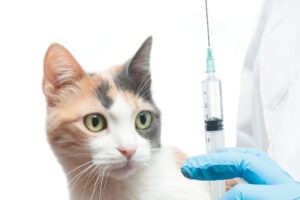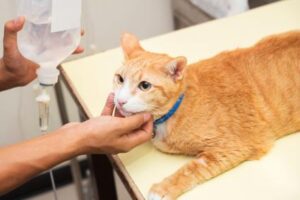Cats are great pets. They have wonderful personalities, and they are cuddly, and best of all, they are very independent animals. Cats clean and groom themselves, and they don’t need to be taken outside to go to the bathroom.
Even though cats are independent, adopting one is a huge responsibility. Your cat will rely on you for food, shelter, love, and affection. It is also up to you to make sure that your cat is healthy by taking them to the vet. Some cat owners wonder do cats really need to go to the vet. The answer to this question is yes. You need to take your cat to the vet if they are sick or injured, and you also need to take your cat to the vet for regular checkups.

Table of Contents
Why Does My Cat Need To Go To The Vet?
Because your cat cannot tell you when there is something wrong and need to go to the vet, it is up to you to recognize the signs.

– In distress:
If your cat is showing signs that they are in distress, you should take them to the vet immediately. If they are crying, howling, or isolating themselves, your cat is trying to tell you that there is something wrong.
– Abnormal litter behavior:
If your cat is spending more time than usual in the litter box or crying while in the litter box, they could have a urinary issue or kidney issues. Both of these problems are very serious and should not be ignored.
– Excessive vomiting:
It isn’t uncommon for a cat to vomit from time to time. When your cat is trying to cough up a hairball, it isn’t uncommon for them to vomit as well. However, if your cat is repeatedly vomiting, they can become seriously dehydrated, which would require help from the vet. Also, the vet will need to figure out why your cat is getting sick so often.
– Excessive weight loss:
If your cat has suddenly lost a great deal of weight, they likely have a medical issue. Losing just two pounds is serious and would require help from the vet.
– Strange lumps or growths:
Some lumps and bumps are harmless, but many are something more serious. If you notice any new growth on your cat, you need to call the vet immediately.
– Excessive coughing or trouble breathing:
If your cat is often coughing, or if their breathing seems shallow, you should call the vet immediately. There are a number of issues that can be causing their symptoms, such as tumors, parasites, exposure to toxins, or respiratory disease.
– Trauma:
Any signs of trauma would warrant an emergency visit to the vet. Trauma can occur if your cat gets hit by a car, stepped on by a human, or if another animal attacks them. All of these issues should be taken seriously.
How Much Does It Cost To Take Your Cat To the Vet?

The cost of a checkup and other services vary, depending on a few different factors. These include:
1. The geographic location
2. The specific vet you choose
3. The provider you choose. A private vet will charge significantly more money than an animal clinic or a non-profit pet care organization.
While these factors do affect the cost that the vet will charge, the average cost of a routine vet checkup is $45 to $55. This doesn’t include the additional services that your cat needs.
Vaccines: $15 to $28 each (Core vaccines for kittens which includes Panleukopenia, Herpesvirus, Calicivirus, Feline Leukemia, and rabies: $80)
Fecal exam: $25 to $45
Heartworm test: $45 to $50

How Often Should I Take My Cat To the Vet?
As mentioned earlier, it is essential to take your cat to the vet regularly. How often your cat needs to see the vet depends on your cat’s age and the quality of their overall health.
Kitten care
Kittens need to go to the vet much more often than adult cats. It is recommended that you take your kitten to the vet every month until they are four months old. Frequent visits are necessary for your kitten to get the necessary vaccinations. The vet won’t do every vaccination at once, so they will need to go back every month. These visits are also essential to make sure that your kitten is healthy and has no underlying conditions. Finally, you will need to bring your kitten back to the vet when they are six months old so that they can be spayed or neutered.

Adult cat care
It is recommended that you bring your adult cat to the vet once a year for a checkup, vaccinations, and dental cleanings. Even if you think that your cat is healthy, you still need to bring them to the vet. Cats tend to suffer in silence, and they can hide their pain well. This is why it is so important that you bring your cat to the vet every year. Some cat owners believe that if they have an indoor cat that annual visits aren’t necessary. This is wrong. Both indoor and outdoor adult cats need to see the vet every year.

Elder cat care
As your cat gets older, they will require more medical attention than younger cats. This is because older cats are more prone to many medical conditions and diseases. When your cat turns 7-years-old, you should start bringing them to the vet twice a year. When your cat is 10-years-old, and up, they will need to see the vet three times a year.

Cats with health concerns
If your cat has any health concerns or health issues, your vet will let you know how often they want you to return based on your cat’s condition. On average, cats with medical conditions or health concerns are seen by the vet twice a year. If your cat’s symptoms or issues worsen between visits, you should schedule an appointment even if they aren’t due for a checkup.
Tips For Taking Your Cat To the Vet
The biggest hassle when it comes to bringing your cat to the vet is getting them there. Unfortunately, you can’t explain to your cat why you need to bring them to the vet. The only thing that you can do is make them less stressed as possible. There are a few tips that you should follow to make the whole experience easier for you and your cat.
Choose the right carrier
The carrier you choose is essential in keeping your cat’s stress level down when going to the vet. Your carrier needs to be large enough for your cat to sit, stand, and make a full turn. It would help if you also went with a carrier that has a top-loading feature. This makes it easier to take your scared cat out when the vet is ready to examine them.
Familiar smells help
Your cat is going to be very stressed while in the car and in the waiting room. A great way to help them relax a bit is to put a blanket in the carrier that smells like home. This will give your cat a sense of peace and well being during a stressful situation.

Get your cat used to the carrier
The worst thing you can do for your cat is to shove them in the carrier right before going to the vet. The fear of the unknown will make your cat not want to go into the carrier. Trying to force them will cause them extreme stress, and they can get injured on the way in. It is best to practice with the carrier a week or two before the appointment. To do this, set the carrier up on the floor with blankets inside, giving your pet a place to nap. You can also put cat treats inside to get your cat to go in. When your cat sees that the carrier is a safe and comfortable place, they will be more willing to get inside on the day of the visit.

Get your cat used to the car
If your cat only gets in the car for vet visits, they will see car rides as something negative. To get your cat ready for the trip to the vet, you should get them used to the car. To do this, start by taking your cat for rides around the block. Over time, you can gradually increase the length of the drive. When the day of the appointment arrives, your cat will be used in the car, and they will be less stressed.
Keep your cat in the carrier until you are in the exam room
The waiting room at the vet can be very stressful for your cat. They will be surrounded by other animals who are barking, growling, meowing, and hissing, which can be a lot. To keep your cat calm and to protect yourself from getting clawed up, you should leave them in the carrier until you are alone in the exam room.

Don’t arrive too early
You may have the desire to leave the house early so that you can get to your appointment early. This isn’t a good idea. Sure, you won’t risk being late for the appointment, but it will be really hard on your cat. As mentioned earlier, the waiting room can be very stressful. The longer your cat remains in the carrier in the waiting room, the more stressed they will become. It is best to arrive at the vet’s office just a few minutes before your scheduled appointment. If your cat is very high strung and they stress easily, you should call the vet before leaving the house to make sure that they are running on time.
Schedule your appointment during less busy times
When you schedule your cat’s appointment, ask if they can be seen during the office’s least busy times. This will allow you to avoid the chaos and the long wait.
Pet and talk to your cat
From the time you put your cat into the carrier until the visit is over, you should talk to your cat in soothing tones. It would help if you also petted your cat as often as possible. This will give them a sense of security, which will make the whole experience less stressful.

Use pheromone spray
Pheromone sprays contain a synthetic form of the scent that cats rub against one another and their loved ones to create a social bond. If you are really worried about your cat stressing out on the day of their visit to the vet, this type of spray can help.
What To Tell Your Vet When You Get There?

When you get into the exam room with your cat, you should start by bringing up any concerns that you have regarding your cat’s health. This will let your vet know what to look for during the exam. You should also bring up any questions or concerns that you have regarding your cat’s diet and behavior.
If your cat hasn’t been microchipped yet, this is something that you should discuss with the vet. It is a relatively painless and inexpensive procedure that will help you and your cat be reunited if they get lost. The peace of mind that microchipping offers is well worth the cost. Your cat’s visit to the vet is a great time to discuss it.
Final Thoughts
Your cat’s health and well being is entirely your responsibility. The best way to be sure that your cat is healthy, and for them to live a long and healthy life is to see the vet regularly. Even if your cat isn’t sick or injured, they still need to see the vet regularly. Finally, your cat should be calm and relaxed during their checkup. If you plan ahead of time and practice with your cat, it should be a simple and stress-free experience for both of you.


